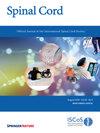神经损伤程度或运动感觉完整性无法解释自主神经损伤
IF 2.2
4区 医学
Q3 CLINICAL NEUROLOGY
引用次数: 0
摘要
研究设计横断面研究.目的确定损伤程度和完整性的常见临床评估与脊髓损伤(SCI)后自主血压不稳定症状和继发性医疗并发症的相关性.地点美国学术医疗中心.方法82名脊髓损伤患者(48 人)和非脊髓损伤患者(34 人)通过脊髓损伤后自主神经功能障碍(ADFSCI)调查量化了自主血压不稳定症状。健康史通过过去一年的尿路感染和住院次数、完成排便程序的时间以及终生压力伤害来量化继发性医疗并发症。我们建立了回归模型,以确定相关关联的强度。神经损伤程度和ASIA损伤量表与自律性血压不稳定症状的相关性很小,仅占回归模型变异性的11.5%。继发性医疗并发症与 SCI 损伤程度和运动/感觉完整性的相关性类似,且极小(R2 = 0.07 和 R2 = 0.03)。与此相反,ADFSCI 中的血压不稳定症状远远优于常见的临床运动/感官床旁检查,与 SCI 后继发性医疗并发症的排序数量具有中等程度的强相关性(R2 = 0.31)。有趣的是,血压不稳定的症状优于临床运动/感官床旁检查,与 SCI 后继发性医疗并发症的相关性更高。本文章由计算机程序翻译,如有差异,请以英文原文为准。


Autonomic impairment is not explained by neurological level of injury or motor-sensory completeness
Cross-sectional study. Determine how well common clinical assessments of level and completeness of injury are correlated with symptoms of autonomic blood pressure instability and secondary medical complications after spinal cord injury (SCI). Academic medical center, United States. Eighty-two individuals with (n = 48) and without (n = 34) SCI had symptoms of autonomic blood pressure instability quantified with the Autonomic Dysfunction Following SCI (ADFSCI) survey. Health histories quantified the secondary medical complications through number of urinary tract infections and hospitalizations in the past year, time to complete bowel program, and lifetime pressure injuries. Regression models were completed to identify strengths of associated correlations. ADFSCI scores were significantly higher in individuals with SCI than controls. Neurological level of injury and ASIA impairment scale were both minimally correlated to symptoms of autonomic blood pressure instability, accounting for only 11.5% of variability in regression models. Secondary medical complications had similar, minimal correlations to level and motor/sensory completeness of SCI (R2 = 0.07 and R2 = 0.03 respectively). Contrasting this, symptoms of blood pressure instability on ADFSCI far outperformed the common clinical motor/sensory bedside exam, with moderately strong correlations to the ranked number of secondary medical complications after SCI (R2 = 0.31). Neurological level of injury and motor/sensory completeness provided limited insights into which individuals with SCI would have blood pressure instability or secondary medical complications. Interestingly, symptoms of blood pressure instability outperform the clinical motor/sensory bedside exam, with higher correlations to secondary medical complications after SCI.
求助全文
通过发布文献求助,成功后即可免费获取论文全文。
去求助
来源期刊

Spinal cord
医学-临床神经学
CiteScore
4.50
自引率
9.10%
发文量
142
审稿时长
2 months
期刊介绍:
Spinal Cord is a specialised, international journal that has been publishing spinal cord related manuscripts since 1963. It appears monthly, online and in print, and accepts contributions on spinal cord anatomy, physiology, management of injury and disease, and the quality of life and life circumstances of people with a spinal cord injury. Spinal Cord is multi-disciplinary and publishes contributions across the entire spectrum of research ranging from basic science to applied clinical research. It focuses on high quality original research, systematic reviews and narrative reviews.
Spinal Cord''s sister journal Spinal Cord Series and Cases: Clinical Management in Spinal Cord Disorders publishes high quality case reports, small case series, pilot and retrospective studies perspectives, Pulse survey articles, Point-couterpoint articles, correspondences and book reviews. It specialises in material that addresses all aspects of life for persons with spinal cord injuries or disorders. For more information, please see the aims and scope of Spinal Cord Series and Cases.
 求助内容:
求助内容: 应助结果提醒方式:
应助结果提醒方式:


